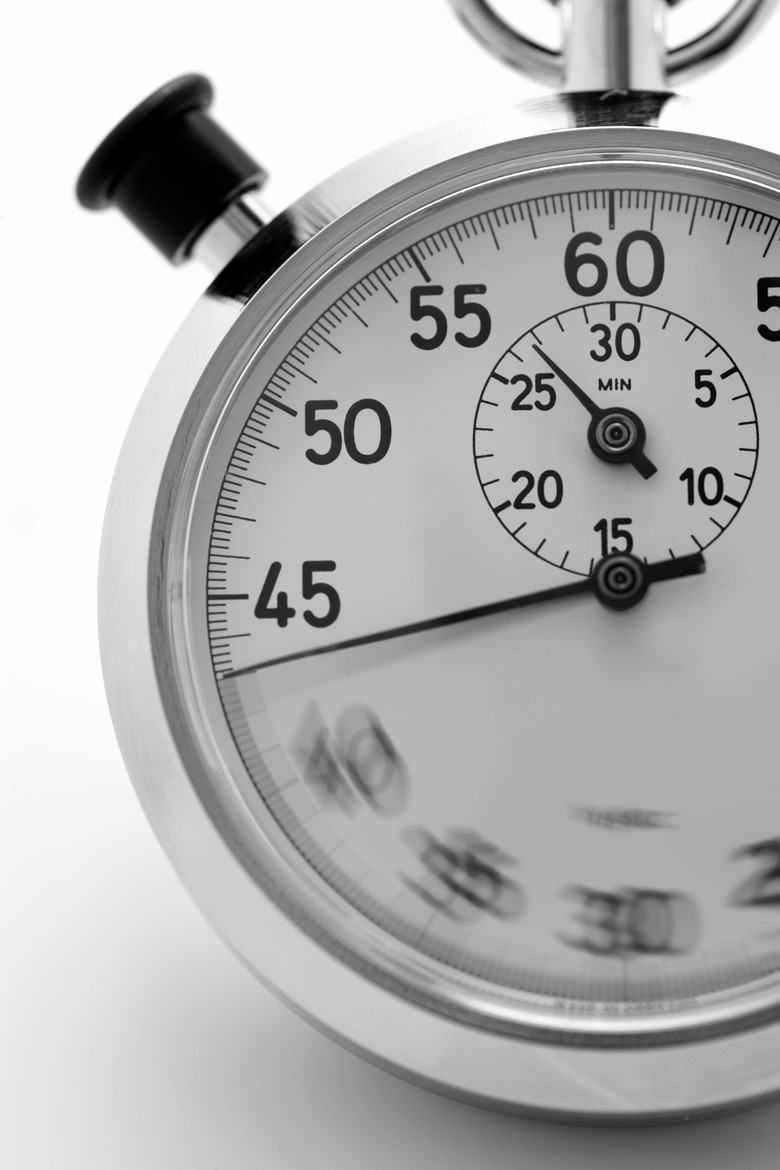How To Calculate Elapsed Time
Time. No one can say with authority what "time" is; the best humans can do is assign common, agreed-upon units to the passage of time and use the concept to organize life on a planet with a number of regular, predictable events related to astronomical phenomena such as the phases of the moon, the summer and winter solstices, and the spring and fall equinoxes.
In ancient times, computers and cell phones were obviously difficult to come by, so the scientists of the day – perhaps with the help of folks who were tired of being late for concerts and such – needed clever ways to keep track of elapsed time, and just as important, a systematic set of numbers and rules to assign to whatever device was used to collect and display the required information.
The Hours-Minutes-Seconds System
The Hours-Minutes-Seconds System
Most things involving math and numbers today are based on 10 numerals (the numbers 0 through 9 inclusive), perhaps because early humans found it easy to count on their fingers.
Time was different even for early cultures; the Egyptians divided the period between sunrise and sunset into 12 parts, perhaps owing to the number of annual lunar cycles but also likely attributable to the number of finger joints on each hand (including the knuckles but excluding the thumb). There was no way for the ancients to know if what is today named "nighttime" lasts as long as what is today called "daytime," but "night" and "daylight" were not then considered to be part of the same "day." Once this changed, a day had 24 periods.
Geometry Meets Time: Splitting up the Hour
Geometry Meets Time: Splitting up the Hour
These individual slices of what is now understood to be a single complete rotation of the Earth about its axis ultimately earned the name hour (from the Latin hora). The division of this period into 60 increments(now dubbed minutes) and 60 divisions of that element (creating seconds) followed from the fact that degrees of a circle were already divided in this same general way, and the most sensible shape for the faces of early clocks was a circle.
Keeping Track of Time Elapsed
Keeping Track of Time Elapsed
Say you wanted to know how much time elapsed between different chosen times of day in hours, minutes and seconds. One way to do this is to convert everything to seconds first and then convert back to hours, minutes and seconds at the end of the problem. For example, say you had a starting time of 3:11:15 and and ending time of 5:28:45. The values on the far left represent increments of 3,600 seconds (60 s/min times 60 min/hr), those in the middle, increments of 60 seconds and those on the right just seconds.
Thus
\(3:11:15 = 3(3600) + 11(60) + 15 = 11,475\text{ s, and }5:28:45 = 5(3600) + 28(60) + 45 = 19,725\text{ s}\)
This is a difference of
\(19,725 – 11,475 = 8,250\text{ s}\)
Since hours come in increments of 3,600 seconds, you fit two of these into this total and have 8,250 – (2 × 3600) = 1,050 seconds left to account for. 60 fits into 1,050 a total of 17 times with a remainder of 30 – in other words, you can divide 1,050 by 60 to get 17.5, or 17 minutes plus half a minute, or 30 seconds. Thus elapsed time is 2 hours, 17 minutes and 30 seconds, or 2:17:30.
The Sundial
The Sundial
The first device created by humans for the purpose of marking the passage of time dates back to approximately 3500 B.C., or about 5,500 years ago. This sundial, and the others that followed, were essentially vertical sticks arranged to cast a shadow on a marked plate.
The concept of "noon" was fostered by these devices. The imaginary line the sun crosses in the sky every day at its highest point (at which the shadow cast by the sundial characteristically narrows to nothing and moves to the other side of the plate) is called a meridian, which translates from Latin to "middle of day.")
The Wristwatch
The Wristwatch
It wasn't until the early 1900s that people began wearing watches on their wrists, and as soon as this began to spread, it often attracted ridicule from knowing people in social circles. But the efficiency of a wrist-worn time piece became evident when soldiers in the first World War used them.
Wristwatches remained popular even after many of them could no longer be really considered jewelry, as was much of the original intention. Such was the case when digital watches became popular in the late 20th century, especially with endurance athletes. In the age of smartphones, watches' popularity has waned.
Fully Automatic Timing
Fully Automatic Timing
Imagine the year being 1700, and having a race in your village to see who's the fastest person on two legs over a distance of 100 meters (about 328 feet). You might be able to sort out the places of the entrants in the championship sprint, but you'd have no way to accurately record any of their times.
Today, super-sensitive equipment called fully automatic timing (FAT), involving laser beams, times runners, horses and cars in competitions in which thousandths of seconds can separate places and determine new speed records.
Cite This Article
MLA
Beck, Kevin. "How To Calculate Elapsed Time" sciencing.com, https://www.sciencing.com/calculate-elasped-time-7529536/. 27 December 2020.
APA
Beck, Kevin. (2020, December 27). How To Calculate Elapsed Time. sciencing.com. Retrieved from https://www.sciencing.com/calculate-elasped-time-7529536/
Chicago
Beck, Kevin. How To Calculate Elapsed Time last modified March 24, 2022. https://www.sciencing.com/calculate-elasped-time-7529536/
